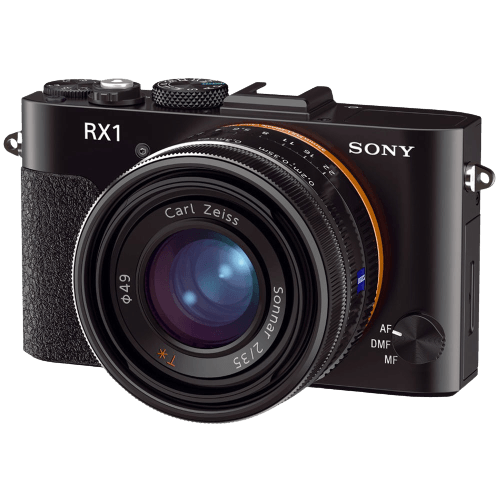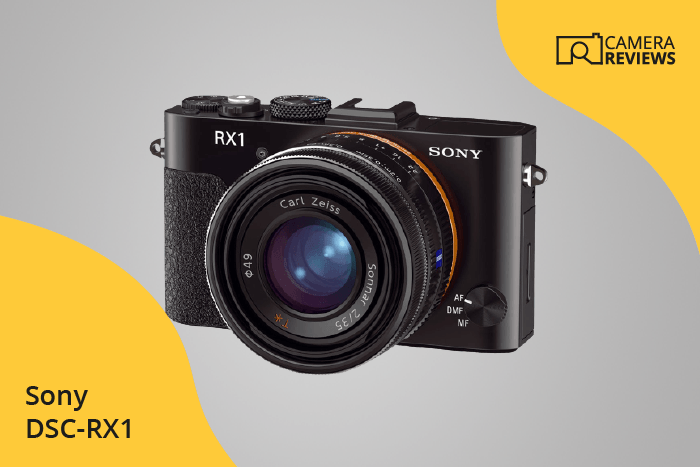Sony Cyber-shot DSC-RX1 Specs and Scores

The Sony Cyber-shot DSC-RX1 scores a 57/100 in our evaluation. It is a compact camera, announced on September 12, 2012, and released in the same year. The camera measures 113 x 65 x 70mm and weighs 482g (1.06lbs), making it a portable choice.
In today’s market, the DSC-RX1’s specifics show that it is a decent camera but may not be the best option for everyone.
Sony Cyber-shot RX1 Overview and Optics
The optics of the Sony Cyber-shot DSC-RX1 receive a score of 67 out of 100. This camera boasts a 24.3-megapixel resolution and a shooting speed of 5 frames per second. Its CMOS sensor, paired with a Bionz processor, achieves a DXOMARK sensor score of 93. The full-frame sensor size and 3:2 aspect ratio contribute to its solid performance.
However, the DSC-RX1 lacks some features found in other modern cameras. It has a fixed lens mount, which means users cannot change the lens to suit different shooting scenarios. Additionally, this camera does not offer image stabilization, which could lead to blurrier images if the user’s hand is not steady.
Despite these limitations, the Sony Cyber-shot DSC-RX1 still delivers quality images with its high-resolution sensor and powerful processor. While it may not be the top choice for those seeking versatility in lens options or advanced stabilization features, it remains a reliable option for photographers who prioritize image quality and simplicity.
Sony Cyber-shot DSC-RX1 Video Performance
The Sony Cyber-shot DSC-RX1 receives a video score of 56/100. This camera offers Full HD video recording with a maximum resolution of 1920 x 1080 pixels. The highest frame rate achievable is 60fps, providing smooth motion capture for fast-moving subjects.
In the current market, the DSC-RX1’s video capabilities may not be as competitive as other cameras, with many offering 4K resolution and higher frame rates. Additionally, the absence of built-in time-lapse functionality limits the creative options for videographers.
Considering these factors, the Sony Cyber-shot DSC-RX1’s video performance is adequate but not outstanding when compared to other options available in the market.
Sony Cyber-shot DSC-RX1 Features and Benefits
The Sony Cyber-shot DSC-RX1 scores 44 out of 100 in the features department. This score reflects the camera’s capabilities and limitations in terms of the features it offers. With a 3-inch screen size and a screen resolution of 1,229,000 dots, the camera provides decent image preview quality. However, it lacks a touchscreen interface which is a common feature in modern cameras.
The camera does have a flip screen, making it convenient for capturing images from various angles. Despite this, the DSC-RX1 does not offer GPS, WIFI, or Bluetooth connectivity, which are essential features for sharing and transferring images in today’s digital age.
Taking all these factors into account, the Sony Cyber-shot DSC-RX1 has a limited set of features compared to other cameras in the market. While it may suffice for basic photography needs, the camera falls short in terms of advanced connectivity and user experience options.
Sony Cyber-shot DSC-RX1 Storage and Battery
The Sony Cyber-shot DSC-RX1’s storage and battery receive a score of 16/100. This camera has one memory card slot, compatible with SD, SDHC, SDXC cards, as well as Memory Stick Pro Duo and Pro-HG Duo cards. The battery life lasts for 270 shots, powered by an NP-BX1 battery. However, this camera does not support USB charging.
Compared to other cameras on the market, the RX1’s storage and battery specifications are subpar. The single memory card slot and limited battery life of 270 shots may not be sufficient for users who require extended shooting sessions or ample storage space. The lack of USB charging also hinders the convenience of recharging the camera.
Taking these specifications into account, the Sony Cyber-shot DSC-RX1’s storage and battery performance falls short of the expectations for a modern camera.
Sony Cyber-shot DSC-RX1 Alternatives
Do you want to know how the Sony Cyber-shot DSC-RX1 compares to its competitors? Have a look at the most popular comparisons for this camera below:
- Nikon Coolpix P1000 vs Sony RX1
- Sony Cyber-shot DSC-RX1 vs DSC-RX10 III
- Canon PowerShot G7 X Mark II vs Sony RX1
- Fujifilm X-T5 vs Sony Cyber-shot DSC-RX1
- Panasonic Lumix DMC-FZ1000 II vs Sony RX1
- Phase One IQ180 vs Sony Cyber-shot DSC-RX1
Sony Cyber-shot DSC-RX1 FAQ
Does the Sony Cyber-shot DSC-RX1 Have Built-in Image Stabilization?
Unfortunately, the Sony Cyber-shot DSC-RX1 does not have built-in image stabilization. Users may need to rely on a tripod or external stabilizer for steadier shots.
Does the Sony Cyber-shot DSC-RX1 Support 4K Video Recording?
The Sony Cyber-shot DSC-RX1 does not support 4K video recording. Its maximum video resolution is Full HD at 1920×1080 pixels.
What Size Sensor Does The Sony Cyber-shot DSC-RX1 Have?
The Sony Cyber-shot DSC-RX1 is equipped with a full-frame sensor, specifically a 35mm Exmor CMOS sensor, which provides high image quality and performance.
Does the Sony Cyber-shot DSC-RX1 Have a Dual Memory Card Slot?
No, the Sony Cyber-shot DSC-RX1 features only a single memory card slot, which is compatible with SD, SDHC, and SDXC memory cards.
Does the Sony Cyber-shot DSC-RX1 Have a Touch Screen?
The Sony Cyber-shot DSC-RX1 does not have a touch screen. Users will need to navigate and control the camera using physical buttons and dials.
Does the Sony Cyber-shot DSC-RX1 Have Wi-Fi and Bluetooth?
Unfortunately, the Sony Cyber-shot DSC-RX1 lacks both Wi-Fi and Bluetooth connectivity options for wireless data transfer and remote control.
Does the Sony Cyber-shot DSC-RX1 Have GPS?
The Sony Cyber-shot DSC-RX1 does not have a built-in GPS feature for geotagging photos or tracking locations.
Is the Sony Cyber-shot DSC-RX1 Weather Sealed?
No, the Sony Cyber-shot DSC-RX1 is not weather-sealed. Users should exercise caution when using the camera in harsh weather conditions or environments.
Does the Sony Cyber-shot DSC-RX1 Have a Built-in Flash?
Yes, the Sony Cyber-shot DSC-RX1 features a built-in flash, allowing users to capture well-lit photos in low-light situations.

